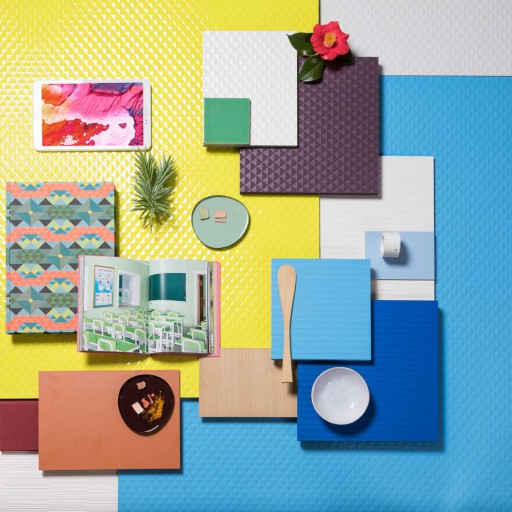Why do yellow lead pencils sell more? Why did Flaubert dress Madame Bovary in blue? Why are girls’ toys pink? Cromorama, the book by Italian art director Riccardo Falcinelli, tries to answer all these questions by getting to the heart of the story of the filter through which we all view reality: colour. It is a look at the past because, as the author says, “nobody has been able to explain the true mechanism for why fashions change when it comes to colours”.
A graphic designer for more than 20 years and a professor of the psychology of perception, Riccardo Falcinelli has dedicated 11 years of his life to researching and building this 480-page work which he discusses in this interview. It’s a book about colour that is full of images taken from paintings, ads, cinema, comics, and popular culture, which serve as a frame for a myriad of stories and anecdotes that help us to understand how colour transforms the way we see the world.
https://www.instagram.com/p/BlYXCzJF8Qz/?utm_source=ig_web_copy_link
Why do boys wear blue and girls wear pink?
“From a communication point of view, colour is a cultural convention”, the author says. What each colour means changes depending on the country and the period in history, and the culture that we live in determines if the right colour to wear to a funeral is black, as it is in the West, or white like in Japan, or red like in South Africa. But it also determines our tastes and the colours that are considered pretty, elegant, daring etc.
This convention is so deeply rooted in our culture that we no longer question it and it has become innate. Falcinelli explains that that’s why blue, which according to physics should be a warm colour, has become a cool colour. We naturally make this association as we have seen it repeated millions of times on weather maps and signs.
But conventions change, and the meaning that colours have change with them. This past Christmas we once again saw ads and catalogues full of pink toys for girls and blue ones for boys. However, this was not always the case. A century ago, the feminine colour was blue, the colour of the Virgin Mary’s veil, while pink was for boys, as it was seen as a softer version of red, or the colour of war. Why the change? For Falcinelli, it was all because of Barbie: “Pink was the iconic colour of her dresses and accessories, and I would say that this was because of President Eisenhower’s wife, who made pale pink fashionable among North American women. Barbie became the best-selling doll and all toymakers made a version of her”.
https://www.instagram.com/p/B09MLjZpSO4/?utm_source=ig_web_copy_link
The Industrial Revolution and the colour revolution
Cromorama points to the Industrial Revolution as the line between two ways of looking at colour. New industrial dyes and the mass production means that nowadays we can have anything in any colour. But before industrialisation, colour was just another material and it determined the price of an object because “colours were made with natural substances, and the rarer these materials were, the more expensive the colours were”. The paradigmatic case of ultramarine blue, which was made with a lapis lazuli reduction, a semi-precious stone: “During the Renaissance, seeing the colour blue was like seeing a Louis Vuitton bag today, something that immediately makes you think that it cost a tonne of money”. Art restorer Olga Gago told us in this interview about how the use of colours in the past was directly determined by economic availability.
https://www.instagram.com/p/B6veojhqocs/?utm_source=ig_web_copy_link
Running away from flat colours
During the Industrial Revolution, flat colour was born, which is a homogeneous type of colour that is used in mass production but that is rarely found in nature. Thanks to flat colour, you can get a can of Coca-Cola in the USA and another in Korea and see that they are exactly the same colour. “As we always get used to things being a certain way, now we want the opposite”, says Riccardo Falcinelli. He points to the use of filters on Instagram that imitate the effects of an exposed or discoloured negative, or the trend of using pastel colours, which seem more natural to us, as being a reaction to this perfection.
We have so many colours around us that we have lost the capacity to get excited in the same way that people did before the Industrial Revolution, when “colour was something precious, rare, and highly desired”. But we have also gotten used to bright colours on the screens that we live with and we are no longer capable of seeing colours in the same way that they would have been seen by a person living 200 years ago.
https://www.instagram.com/p/BHb8YWlj4IJ/?utm_source=ig_web_copy_link
Colour Conditioning: the yellow pencil
Many scientific studies show that colour is the first thing our brain sees. This is seen in some unusual situations mentioned in the book, such as the case of the Samsonite suitcase test: when lifting two suitcases that weighed the same and were exactly alike except for their colours (one was black and the other was white), participants in the study said that the black one was heavier, and when the effort they needed to lift the black one was measured, they were actually more tired after lifting it. Falcinelli explains that “we are used to black things being heavier. Therefore, when the brain sees black, it prepares the muscular system for greater effort, meaning that when lifting the black suitcase, they were effectively using more effort than when they were picking up a white one that weighed exactly the same”.
Falcinelli explains that “colour is the thing we remember the most because it is imprinted on the mind”, and brands have realised this power. If you need to buy a lead pencil, you are 70% more likely to go home with a yellow one, given that two thirds of the lead pencils sold worldwide are yellow. They now form part of the collective imagination: “Pencils are so closely associated with this colour that an experiment was done in which two identical pencils, one yellow and one green, were given to members of the public, and the majority said that the yellow one wrote better”.




